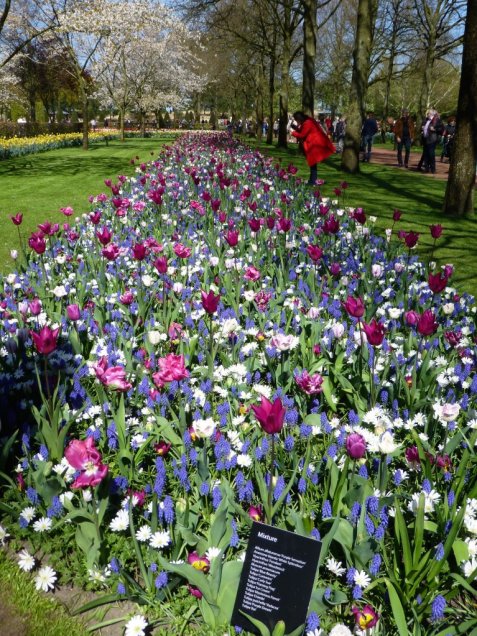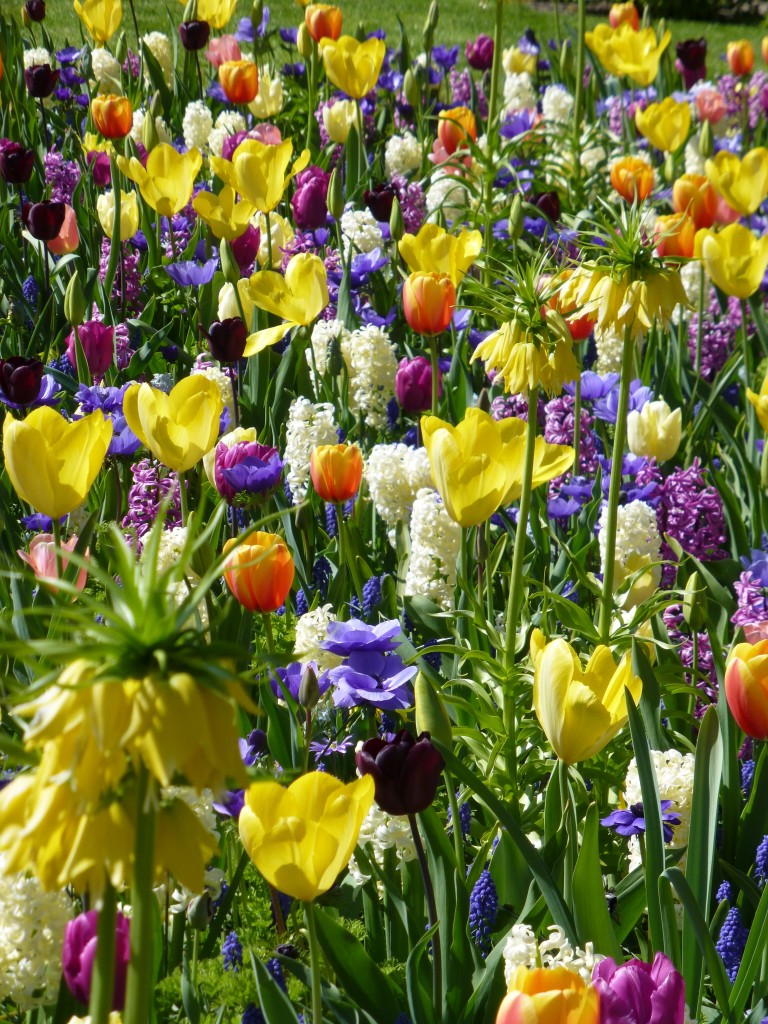 Bulbs are opportunists. Most come from the far Eastern end of the Mediterranean, from rocky scree where early snow melt gives a source of water before summer drought. The busting into leaf and flower comes from energy suppled by a modified root and shoot system stored in their fleshy cells. Photosynthesis and pollination accomplished, they retreat below ground before a hungry goat munches them. This retreat into dormancy means they are easy to transport and so it was that the Dutch fully exploited this market in the late 16th Century. They raised their economic horizon beyond the herring harvest and whaling to world exploration. Bulbs would be heaved into the hold on the return leg of a trading voyage. The bulb market was a pretty new thing then. In the early part of the century, the Turks had besieged Vienna. European potentates were keen to engage in diplomacy with the Sultan at the Topkapi Palace and en route there, the ambassador for the Holy Roman Emperor saw glistering fields of native flowering bulbs. At the palace itself, a total love affair with tulips was on show - omnipresent on wall and floor tiles, etched in glass and carved on furniture. At flowering time there was a festival, hundreds of tortoises with candles on their shells ambling amongst the tulips. The mania for tulips, once they reached the European market, is well recorded. One bulb reaching the price of a mansion in Amsterdam. When the bubble burst in the 17th Century, the Dutch hung on to the growing, breeding, hybridising and exportation of these plants. When I first started gardening, I worked for a giant Father Christmas of a Dutchman, pipe smoking and clog wearing, who had come to England as a bulb sales rep.
Bulbs are opportunists. Most come from the far Eastern end of the Mediterranean, from rocky scree where early snow melt gives a source of water before summer drought. The busting into leaf and flower comes from energy suppled by a modified root and shoot system stored in their fleshy cells. Photosynthesis and pollination accomplished, they retreat below ground before a hungry goat munches them. This retreat into dormancy means they are easy to transport and so it was that the Dutch fully exploited this market in the late 16th Century. They raised their economic horizon beyond the herring harvest and whaling to world exploration. Bulbs would be heaved into the hold on the return leg of a trading voyage. The bulb market was a pretty new thing then. In the early part of the century, the Turks had besieged Vienna. European potentates were keen to engage in diplomacy with the Sultan at the Topkapi Palace and en route there, the ambassador for the Holy Roman Emperor saw glistering fields of native flowering bulbs. At the palace itself, a total love affair with tulips was on show - omnipresent on wall and floor tiles, etched in glass and carved on furniture. At flowering time there was a festival, hundreds of tortoises with candles on their shells ambling amongst the tulips. The mania for tulips, once they reached the European market, is well recorded. One bulb reaching the price of a mansion in Amsterdam. When the bubble burst in the 17th Century, the Dutch hung on to the growing, breeding, hybridising and exportation of these plants. When I first started gardening, I worked for a giant Father Christmas of a Dutchman, pipe smoking and clog wearing, who had come to England as a bulb sales rep. 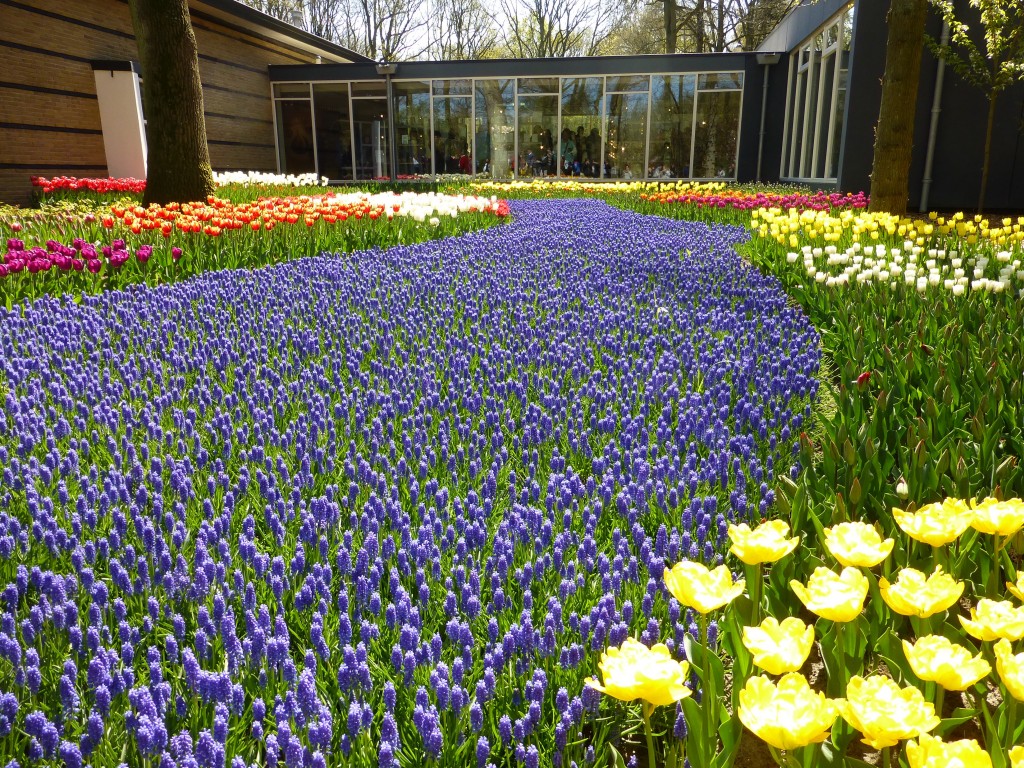 This and the dizzying harlequin pictures of the Keukenhoff gardens lured me and some friends to visit The Netherlands. This garden is Holland’s Eiffel Tower - we were a little nervous of its popularity: the website boasts 1 million visitors per annum (all squeezed into bulb time), the charabancs are there in photographs, the people pouring through, the traffic jams. And by the way, this at 18 euros a head is a complete marketing triumph for the top 100 bulb companies who are just showing off their wares. It being our first Bulb holiday, we started gently Our first port of call, the Hortus Bulborum, in the lee of the church of Limmen - a small village which gives the side bonus of horticultural snooping in front gardens. The Hortus is a charity. Its mission to save old varieties from extinction. A look at a bulb catalogue shows the furiously busy breeding programme for tulips. So many new types condemn the unfashionable to extinction. 90 percent of the tulips at the Hortus growing in the tidy rows staked out in front of the graveyard, are no longer available on the open market. There are metres and metres of highly scented hyacinths that look more like bluebells than the stumpy drumsticks we now grow. And as for the narcissi, this is the the place to pick out that perfect daffodil for the exact subtle colour shade and complement of leaves.
This and the dizzying harlequin pictures of the Keukenhoff gardens lured me and some friends to visit The Netherlands. This garden is Holland’s Eiffel Tower - we were a little nervous of its popularity: the website boasts 1 million visitors per annum (all squeezed into bulb time), the charabancs are there in photographs, the people pouring through, the traffic jams. And by the way, this at 18 euros a head is a complete marketing triumph for the top 100 bulb companies who are just showing off their wares. It being our first Bulb holiday, we started gently Our first port of call, the Hortus Bulborum, in the lee of the church of Limmen - a small village which gives the side bonus of horticultural snooping in front gardens. The Hortus is a charity. Its mission to save old varieties from extinction. A look at a bulb catalogue shows the furiously busy breeding programme for tulips. So many new types condemn the unfashionable to extinction. 90 percent of the tulips at the Hortus growing in the tidy rows staked out in front of the graveyard, are no longer available on the open market. There are metres and metres of highly scented hyacinths that look more like bluebells than the stumpy drumsticks we now grow. And as for the narcissi, this is the the place to pick out that perfect daffodil for the exact subtle colour shade and complement of leaves. 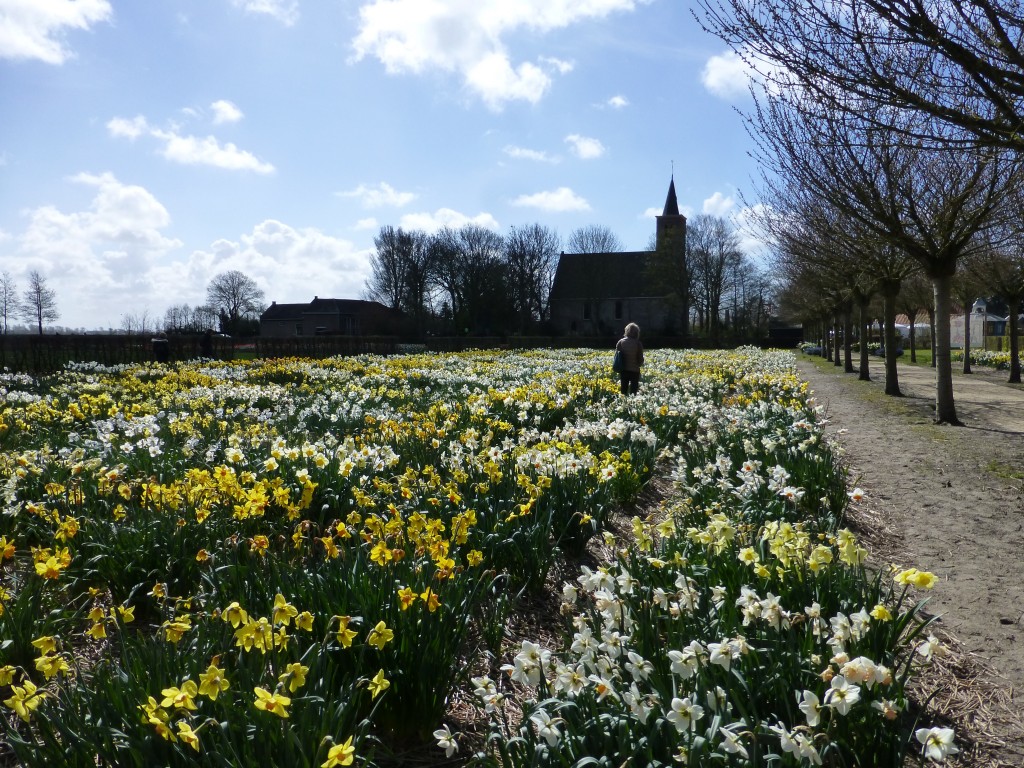 Strictly uncommercial, we had the collection of 4,000 bulbs pretty much to ourselves. Keukenhoff is only one hour on. We parked in one of those heart-sinkingly large carparks and joined a human tide towards the oompapa band. In log jamb of people, we felt like refuseniks for the Notting Hill Carnival. But we were denied the snooty satisfaction of disappointment. Forget the 7 million bulbs on display (7 for each person). The display boggled our eyes and our minds.
Strictly uncommercial, we had the collection of 4,000 bulbs pretty much to ourselves. Keukenhoff is only one hour on. We parked in one of those heart-sinkingly large carparks and joined a human tide towards the oompapa band. In log jamb of people, we felt like refuseniks for the Notting Hill Carnival. But we were denied the snooty satisfaction of disappointment. Forget the 7 million bulbs on display (7 for each person). The display boggled our eyes and our minds. 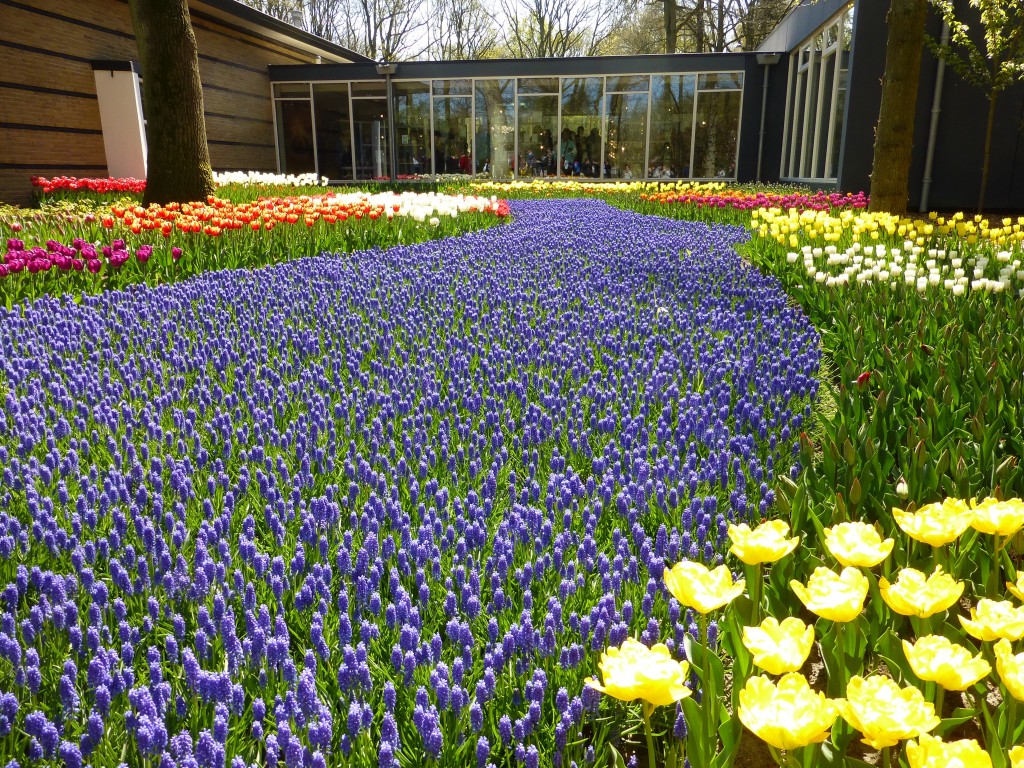 Flowering bulbs run in a liquid flow of curving, undulating colour beneath trees, up slope and down. Sometimes pouring out of buildings. Sinuous, jaunty and eye searing in colours. Every bed is labelled so drool and desire can lead to acquisition. Then when you have seen enough beds of hyacinths glissading into narcissi or two tone tulips aplenty, the next surprise is in the co planting of different bulbs. The more intricate like a detail from a medieval tapestry. The simplest recipe had yellow imperial fritillary with a tulip called Blue Diamond (actually pink rather than blue). Others resembled a jazzy take on dolly mixture, however my heart was stolen by a rendition in white, blue and purple including of anemones, grape hyacinths and 10 types of tulips.
Flowering bulbs run in a liquid flow of curving, undulating colour beneath trees, up slope and down. Sometimes pouring out of buildings. Sinuous, jaunty and eye searing in colours. Every bed is labelled so drool and desire can lead to acquisition. Then when you have seen enough beds of hyacinths glissading into narcissi or two tone tulips aplenty, the next surprise is in the co planting of different bulbs. The more intricate like a detail from a medieval tapestry. The simplest recipe had yellow imperial fritillary with a tulip called Blue Diamond (actually pink rather than blue). Others resembled a jazzy take on dolly mixture, however my heart was stolen by a rendition in white, blue and purple including of anemones, grape hyacinths and 10 types of tulips. 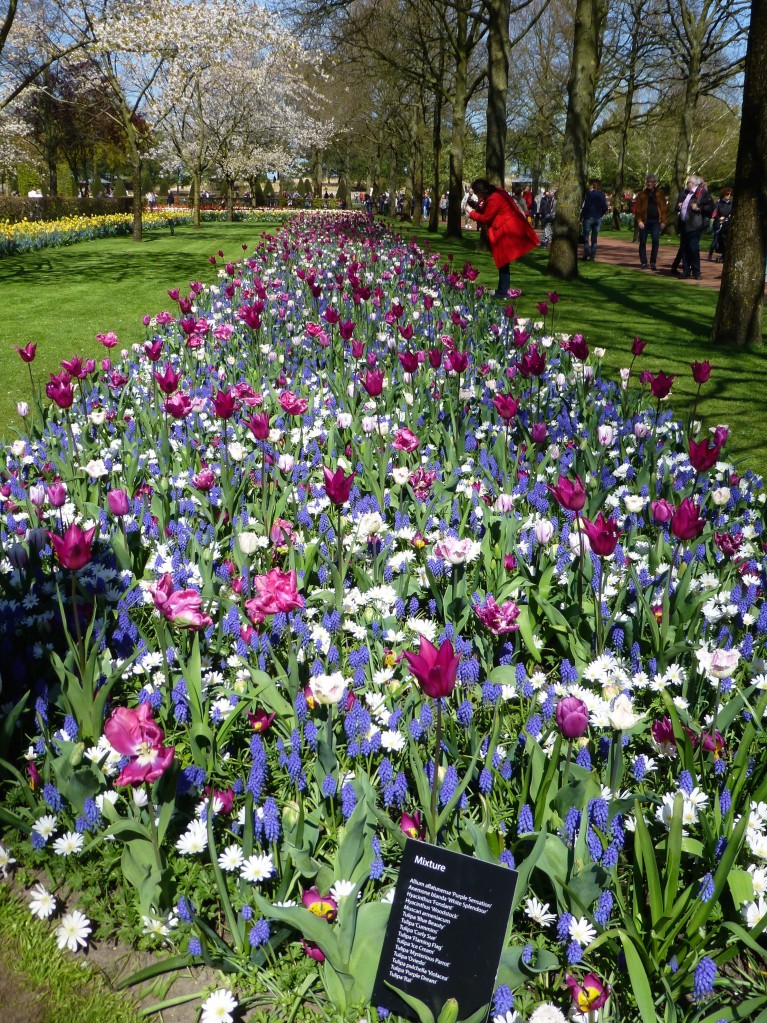 Keukenhoff on-line will tell you the recipe mixture to the square metre. I rendered my 5 square into a Vanity Keukenhoff project, town garden size. Experiments always allure, but this time It feels like I have dressed a bit of the garden for a ball when it is actually going to a barn dance.
Keukenhoff on-line will tell you the recipe mixture to the square metre. I rendered my 5 square into a Vanity Keukenhoff project, town garden size. Experiments always allure, but this time It feels like I have dressed a bit of the garden for a ball when it is actually going to a barn dance.
